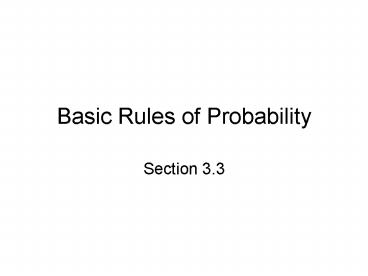Basic Rules of Probability
Title:
Basic Rules of Probability
Description:
Basic Rules of Probability Section 3.3 The Axioms If E is an event and is a subset of S, the sample space, then the following are true: 0 P(E) 1 The ... –
Number of Views:67
Avg rating:3.0/5.0
Title: Basic Rules of Probability
1
Basic Rules of Probability
- Section 3.3
2
The Axioms
- If E is an event and is a subset of S, the sample
space, then the following are true - 0 P(E) 1 The probability of an event E is
between 0 and 1 inclusive. - P( ) 0 The probability of an empty set is
zero. Consequence IF P(A n B) 0 then - A n B which implies A and B are
mutually exclusive. - 3. P(S)1 The probability of the sample space
is 1.
3
More Axioms
- 4. The rule for unions in general is
P(A U B) P(A) P(B) P(A n B) - 5. If A and B are mutually exclusive then
P(A U B) P(A) P(B). - 6.The rule for complimentary events is
P(E) 1 P(E).
4
Examples
- Let E be the event of tossing two dice such that
the sum of the face is even. Let F be the event
that the sum of the faces is greater than 9. - What is the probability of the sum of the faces
being even and greater than 9. - What we are looking for is P(E n F). The only
rolls that correspond to that event are (6,4),
(4,6), (5,5), (6,6). - Thus P(E n F)4/361/9.
- What is the probability of the sum being even or
greater than 9. - Want to compute P(E U F).
- USE AN AXIOM P(E U F)P(E)P(F)-P(E n
F)1/21/6-1/95/9
5
61 p.155
- Of all flashlights in a large shipment, 15 have
a defective bulb, 10 have a defective battery,
and 5 have both defects. If you purchase a
flashlight from the shipment what are the
probabilities of the following - A defective light bulb or a defective battery,
- A good bulb or a good battery,
- A good bulb and a good battery.
6
ANSWERS
- L be the event of having a bad light bulb.
- B be the vent of having a bad battery.
- L is the event of having a good light bulb.
- B is the event of having a good battery.
- P(L)0.15, P(B)0.10, P(L n B)0.05
- The probability of having a bad bulb or bad
battery is P(L U B)P(L)P(B)- P(L n B) - 0.150.10-0.050.2020.
- The probability of having a good bulb or good
battery is P(L U B). - Using deMorgans law L U B(L n B)
- Thus P(L U B) P((L n B))1-P(L n B)1-0.05
0.95 95 - The last part where we have a good bulb and good
battery is P(LnB)P((L U B))1-P(L U
B)1-.2.880































